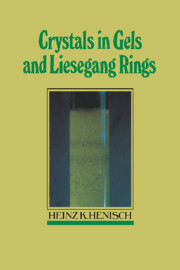1 - History and nature of the gel method
Published online by Cambridge University Press: 06 January 2010
Summary
Introduction
It has long been appreciated that advances in solid state science depend critically on the availability of single crystal specimens. As a result, an enormous amount of labor and care has been lavished on the development of growth techniques. In terms of crystal size, purity, and perfection, the achievements of the modern crystal grower are remarkable indeed, and vast sections of industry now depend on his products. So do the research workers whose preoccupation is with new materials, no matter whether these are under investigation for practical reasons or because a knowledge of their properties might throw new light on our understanding of solids in general.
In one way or another, a very large number of materials has already been grown as single crystals, some with relative ease and others only after long and painstaking research. Nevertheless, there are still many substances which have defied the whole array of modern techniques and which, accordingly, have never been seen in single crystal form. Others, though grown by conventional methods, have never been obtained in the required size or degree of perfection. All these constitute a challenge and an opportunity, not only for the professional crystal grower but, as it happens, also for the talented amateur. New and unusual methods of growing crystals are therefore of wide interest; and if the crystals are by themselves beautiful, as they often are, there is no reason why this interest should be confined to professional scientists.
- Type
- Chapter
- Information
- Crystals in Gels and Liesegang Rings , pp. 1 - 28Publisher: Cambridge University PressPrint publication year: 1988



